It is quite clear, regardless of network, that the digital space has become a competitive one for businesses. Every company on the internet is vying for the attention of the same users (in one way or another), making effective marketing to your target customer more and more difficult. On top of that, average costs of pay per click ads are increasing.
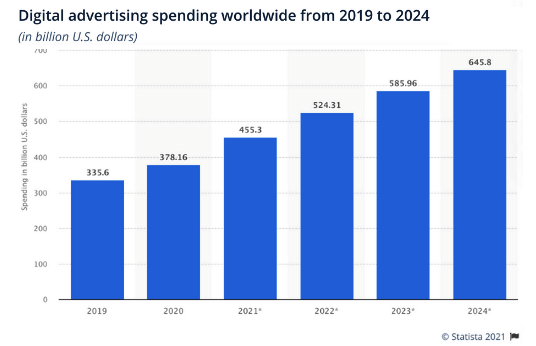
It’s important to make sure your systems and processes for acquiring new customers via these spaces are cost-effective. Aside from running or maintaining perfectly crafted paid media campaigns, there are a variety of methods you can use to lower your customer acquisition costs, or least make that figure maintainable and scalable over time.
So in this post, I’m going to cover
- Define customer acquisition and customer acquisition cost (CAC)
- Explain the difference between CAC and CPA
- Provide 11 tips and tactics you can implement to lower your customer acquisition cost.
What is customer acquisition?
Just as it sounds, it means the acquisition of paying customers to your business. However, it does not refer just to that one action of clicking “purchase” or signing a contract. It encompasses the full path from prospect to paying customer.
For some businesses (ecommerce in particular), that path may be short in duration with few stops along the way. For others with a longer sales cycle, it could be weeks, months, or even years.
Regardless, a customer acquisition strategy aims to ensure that every step in the journey to becoming a customer is as seamless as it can be, allowing you the highest possible conversion rates.
Building out and understanding your business’s funnel is one of the most difficult things for any marketer to undertake, particularly when you don’t have the data to support your decisions. We’ll get into that later, but I’d like to also review the difference between CAC and CPA.
Customer acquisition cost vs cost per acquisition
One thing we need to make clear is that customer acquisition cost (CAC) is not the same as cost per acquisition (CPA).
What is customer acquisition cost (CAC)?
You calculate your customer acquisition cost by dividing your overall advertising spend by the number of new customers you received as a result. CAC is the most important metric when running direct-response advertising campaigns, but in many cases, it is used for measuring the success of your marketing at a business level, as opposed to a campaign level.
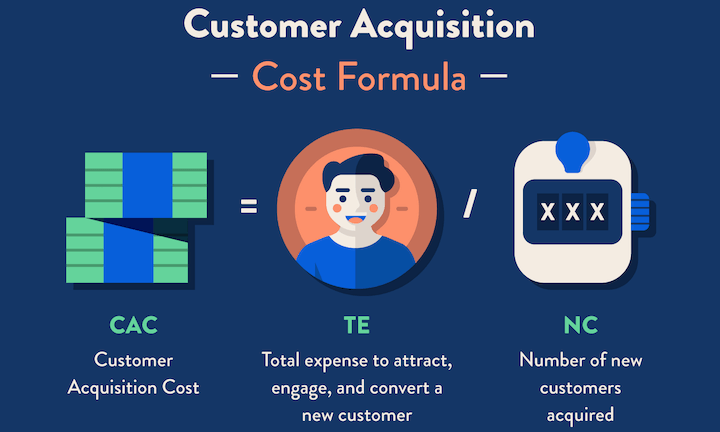
What is cost per acquisition (CPA)?
Cost per acquisition, on the other hand, is more of a campaign-level metric. CPA is simply the cost to acquire a lead (so, anyone but a paying customer), whether through a content download, free trial, demo request, or any other submission of contact information with intent.
In the grand scheme of things, CPA is important but the conversion rate throughout the funnel is more so. Let’s say for example, you are driving leads for a sales demo or consultation. Although this lead type may be considered very low-funnel, there may be a large discrepancy between how many leads convert on this action and how many of them become paying customers.
Depending on the nature of your business and sales operations, you may be able to sacrifice a higher CPA if the conversion to customer and return on ad spend is high. This becomes a crucial factor when competing with other businesses for valuable ad real estate.
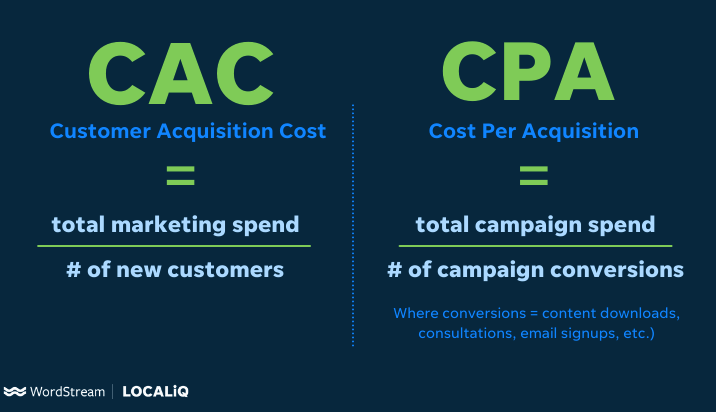
As stated previously, if you are running ads for ecommerce then the difference between CAC and CPA may be minimal as you can instantaneously see whether your ads are making you money.
The first action a user takes could very well be to go to your online store and make a purchase.
How to lower your customer acquisition costs
In this section, I will run through 11 tips and tactics to help you lower your customer acquisition costs, or at the very least, begin to think about how to improve the overall efficiency of your marketing funnel.
1. Have tracking in place
I cannot stress enough how absolutely critical it is to have accurate tracking in place. From ad click to website visit, to lead, to customer, you need to know which traffic is coming from which channel and ideally, which campaign.
Don’t just send users aimlessly to a landing page without setting up conversion tracking within each platform first. That’s where you will be able to get the baseline CPAs and make optimizations within the campaigns themselves.
Whether you use individual landing pages or forms specific to the channel you are advertising on, or create UTM parameters, it is essential to be able to tie performance to specific campaigns. And be sure to set up conversion values so you can connect paid advertising spend directly to leads within your pipeline.
2. Set a baseline
Given the vast differences between businesses and sales cycles, it may take some time to arrive at your CAC. If leads come into your pipeline but take months to convert to customers, it may look like you are in the red for some time.
This is why determining the baseline conversion rates for your promotions, channels, and platforms is crucial. Once you understand the average conversion rates throughout your funnel you can begin to accurately predict the CAC.
3. Align your ads accordingly
Yes, leads acquired through a demo request are much more likely to convert into a paying customers than those acquired through a content download. But an ad promoting a free trial for a project management platform is not going to perform well for users simply looking for project management tips or templates. In this instance, it would make more sense to promote a free guide or template. You can then create retargeting ads for incrementally lower-funnel offers based on who’s engaging with each preceding ad.
The point is, some businesses think they can target prospects with bottom-funnel promotions entirely and drive scalable profitable returns. Although this can work for some, most will find their conversion rates plummet and customer acquisition cost (CAC) skyrocket. Keep your customer acquisition cost low by spending on offers most likely to convert at each stage of the funnel.
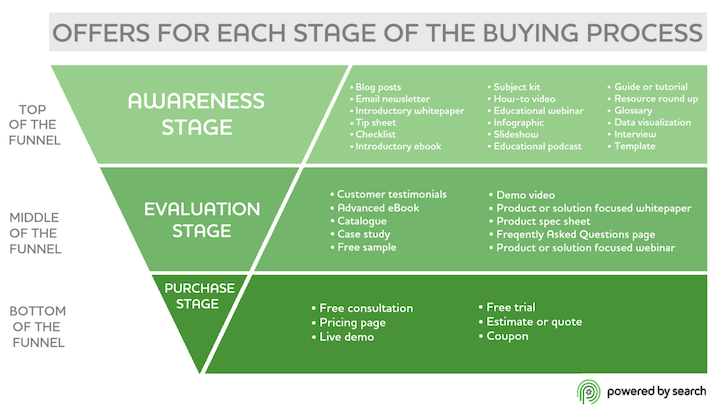
For tips on doing this through Facebook ads, check out these 5 Steps to a Conversion-Driven Facebook Ads Sales Funnel.
4. Have a clear path to conversion
I could have named this section “optimize your funnel” but doing so would oversimplify the point I am trying to make. The greater framework of the marketing funnel comprises the minor components of promotions or offers.
In addition to making sure your offers align with your users’ stage in the funnel, you should also make sure your subsequent offers align with the path they’re most likely to take. For example, the top of your funnel may contain content downloads, however, you may have several different pieces of content. It’s important to strategize that content and align it with the target audience, their needs, and ensure there is a direct path to sales from that conversion.
And then, be sure to strategize your subsequent offers. Leads that download guide A might be interested in a different retargeted ad offer than leads that downloaded guide B, or who used your free tool.
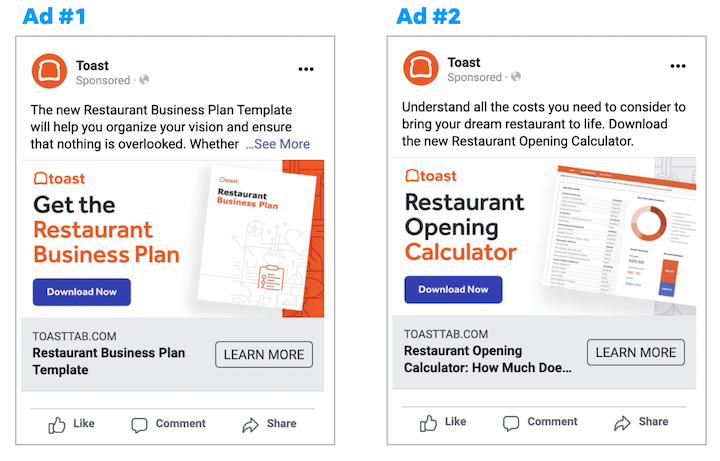
Create somewhat gradual, but clear, paths to conversion based on your sales cycle and the offer that acquired the lead. This way you can avoid drop offs in conversion rate from lead to sales. For example, a content download loosely associated with your product or service will need several more mini conversions before they convert to a customer. You want to strategize every layer of your marketing funnel to align perfectly with directing the prospect towards sales, at the right pace.
5. Use landing pages
Now, there are ways to increase conversion rates without touching a single landing page, but this is not supposed to be your entire strategy.
I still see many folks not using them. In other words, they create ad campaigns that send individuals directly to their website in hopes that prospects will convert there. Even if you have a conversion-optimized website, I advise against this because there are too many options on your website that can (and will) distract the user from converting on the action you are targeting with your ad.
Create landing pages specific to the offers in your ads so that the only CTA on that landing page is the action you want them to take. And here you can include important details in your landing page copy to address any hesitations, convey your value proposition, and get more conversions.
6. Optimize your website and landing page experience
One of the most common discussions for decades at this point is the website experience. Books, articles, videos, and webinars have all discussed the important roles your website plays in the grand scheme of converting prospects into customers.
First, there needs to be complete continuity between your ad and landing page (learn more in our landing page tips). The copy and imagery should look and feel the same and communicate the exact same message.

There should be no dissonance between these two components. The ad should align perfectly with the page that users are being directed to. This is one of the easiest ways to increase conversion rates and lower your customer acquisition cost.
As far as web speed goes, you should ensure your website does not take too long to load and is easily navigable. Regardless of whether you are using a landing page that is hosted on something like HubSpot or Unbounce, many individuals will want to browse your primary site before making any purchasing decision. You can learn how to optimize your page speed here.
7. Get into the weeds of conversion data
Whether it’s through looking at Google Analytics data or the conversion information provided within the advertising platforms (YouTube Studio may surprise you), it is important to understand as much as you can about the conversions taking place, such as:
- What time of day
- Which day of the week
- Which devices
If you find that most of your leads convert through the time window of 9AM to 5PM Monday through Friday, schedule your ads to only run at those times to get the most out of your ad spend and lower your CAC.
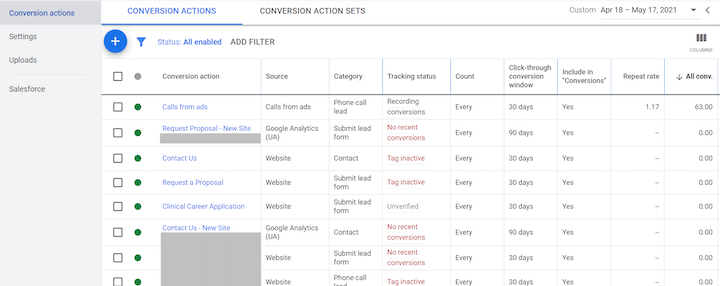
If you see that desktop users are costlier to acquire but are much higher in quality, then you should allow yourself to spend more to acquire these users and eliminate or separate mobile users entirely.
Get into the weeds on your conversion data so you can spend more only where and when you need to instead of increasing costs overall and wasting spend.
You can also check to see if you’re wasting spend with our free Google Ads Performance Grader.
8. Check your placement settings
There are multiple layers to an effective paid ad strategy that could warrant several blog posts, but a lot can be achieved just by paying attention to the details of how your campaigns are set up. The first detaili to check is, on the Facebook or YouTube side of things, the placements you are targeting. For example, many businesses will run direct response campaigns while having the setting for “automatic placements” enabled at the ad set level:

This will automatically include the “Audience Network” which will serve your Facebook ads across various app properties.
In my experience, the Audience Network has historically driven very low-quality clicks and few, if not any, conversions. Although Facebook’s algorithm is engineered to deliver the most results for a chosen goal as possible, oftentimes there will be a good amount of wasted spend on the Audience Network placement.
You can check to see if you’re wasting spend with our free Facebook Ads Performance Grader.
9. Check your location settings
Another good example of campaign settings that can influence CAC is the location targeting in Google Ads. When going through your search campaign’s setting you will notice a section for locations:
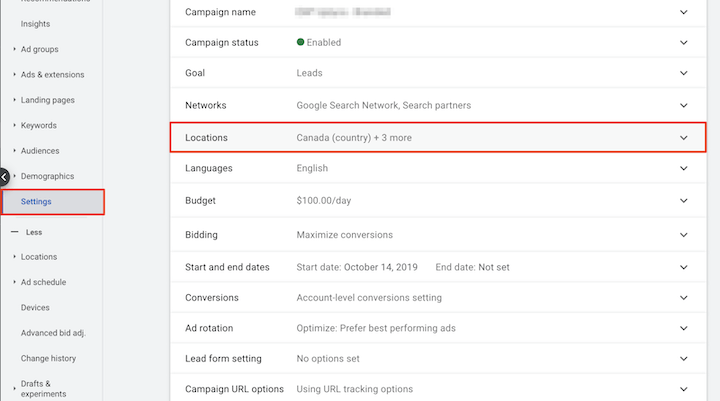
If your business needs to serve ads to individuals within a specific location, expand the locations tab and select “people in or regularly in” your target area, and make exclusions as needed.
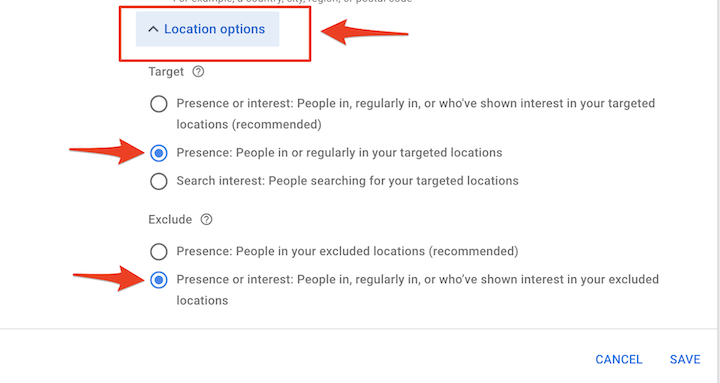
Many times, some of the smallest details within the setup of a paid advertising campaign can have the biggest impact on the quality of leads that you drive through it—and ultimately, your CAC.
10. Use bidding strategies
The last component of paid advertising that can impact your customer acquisition cost is your bid strategy. Leveraging bid strategies (within Google and Bing at least) can greatly improve your base CPA and subsequently your CAC. With campaigns that have had enough conversion data, I have found Target CPA bidding as an effective strategy for maintaining average costs for paid search campaigns.
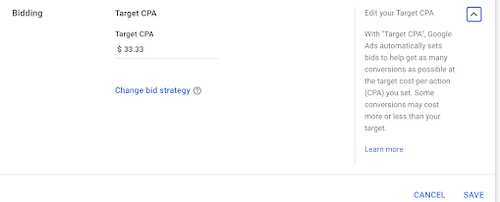
Of course, there are many factors and layers to the funnel deeper than the costs at the top but you should take advantage of any way you can improve these metrics. Take into consideration the audience (or keyword) and funnel/promotion when making decisions on how competitive you should be.
11. Create great content
You can’t escape it. Marketing success always comes down to content. The guides and collateral you produce, their landing page copy, the ad copy that promotes them (and other non-content offers). If you want to lower your customer acquisition costs, you’ve got to write copy that sells.
How to lower your customer acquisition cost [recap]
As you can see, for businesses with a longer sales cycle, lowering customer acquisition cost (CAC) requires increasing conversions and lowering the cost of those conversions (CPA) throughout your entire funnel. In this post, we’ve provided 11 ways to do that:
- Have tracking in place
- Set a baseline
- Align your ads accordingly
- Have a clear path to conversion
- Use landing pages
- Optimize your website and landing page experience
- Get into the weeds of conversion data
- Check your placement settings
- Check your geotargeting settings
- Use bidding strategies
- Write great content







